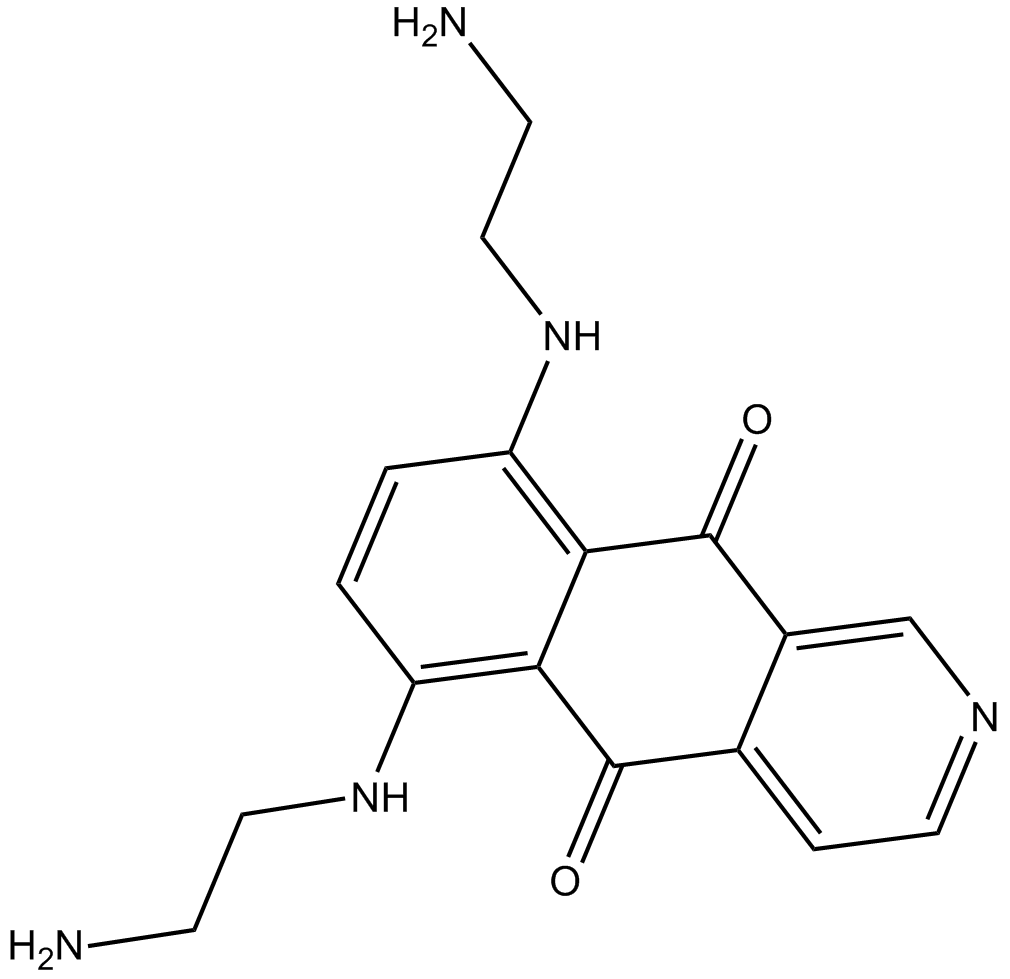Pixantrone |
| Catalog No.GC12503 |
Pixantrone (BBR 2778 (free base)), a mitoxantrone analog, is a topoisomerase II inhibitor and DNA intercalator, with anti-tumor activity.
Products are for research use only. Not for human use. We do not sell to patients.

Cas No.: 144510-96-3
Sample solution is provided at 25 µL, 10mM.
Pixantrone is a topoisomerase II inhibitor and DNA intercalator, with anti-tumor activity.
Pixantrone is a topoisomerase II inhibitor. Pixantrone induces cell death in multiple cancer cell lines independent of cell cycle perturbation, with IC50s of 37.3 nM, 126 nM and 136 nM for T47D, MCF-10A and OVCAR5 cells, respectively. Pixantrone induces DNA damage at high concentrations (500 nM) but not at concentrations (100 nM) sufficient to kill PANC1 cells. Pixantrone (25 or 100 nM) induces severe chromosomal aberrations and mitotic catastrophe in PANC1 cells. Pixantrone (100 nM) may disrupt chromosome segregation because of generating merotelic kinetochore attachments that cause chromosome non-disjunction[1]. Pixantrone potently inhibits growth of human Leukemia K562 cells, etoposide-resistant K/VP.5 cells, MDCK and ABCB1-transfected MDCK/MDR cells, with IC50s of 0.10 μM, 0.56 μM, 0.058 μM and 4.5 μM, respectively. Pixantrone (0.01-0.2 μM) leads to a concentration-dependent formation of linear DNA through acting on topoisomerase IIα. Pixantrone produces semiquinone free radicals in an enzymatic reducing system, although not in a cellular system, most likely due to low cellular uptake[2]. Pixantrone (0.01-10 μM) shows potent inhibitory activities against rat 97-116 peptide-specific T cell proliferation[4].
Pixantrone (27 mg/kg) does not worsen pre-existing moderate degenerative cardiomyopathy in doxorubicin-pretreated mice, by i.v. one dose every 7 days repeated thrice (q7d × 3). Pixantrone (27 mg/kg) causes minimal cardiotoxic in mice following repeated treatment cycles. Moreover, Pixantrone results in less mortality than mitoxantrone in doxorubicin-pretreated mice[3]. Pixantrone (16.25 mg/kg i.v, q7d × 3) modulates Lymph node cells (LNC) responses, and affacts T cell subpopulations in TAChR-immunized Lewis rats. Pixantrone also shows preventive and therapeutic effect in experimental autoimmune myasthenia gravis (EAMG) rats[4].
Reference:
[1]. Beeharry N, et al. Pixantrone induces cell death through mitotic perturbations and subsequent aberrant cell divisions. Cancer Biol Ther. 2015;16(9):1397-406.
[2]. Hasinoff BB, et al. Mechanisms of Action and Reduced Cardiotoxicity of Pixantrone; a Topoisomerase II Targeting Agent with Cellular Selectivity for the Topoisomerase IIα Isoform. J Pharmacol Exp Ther. 2016 Feb;356(2):397-409.
[3]. Cavalletti E, et al. Pixantrone (BBR 2778) has reduced cardiotoxic potential in mice pretreated with doxorubicin: comparative studies against doxorubicin and mitoxantrone. Invest New Drugs. 2007 Jun;25(3):187-95.
[4]. Ubiali F, et al. Pixantrone (BBR2778) reduces the severity of experimental autoimmune myasthenia gravis in Lewis rats. J Immunol. 2008 Feb 15;180(4):2696-703.
Average Rating: 5 (Based on Reviews and 8 reference(s) in Google Scholar.)
GLPBIO products are for RESEARCH USE ONLY. Please make sure your review or question is research based.
Required fields are marked with *




















